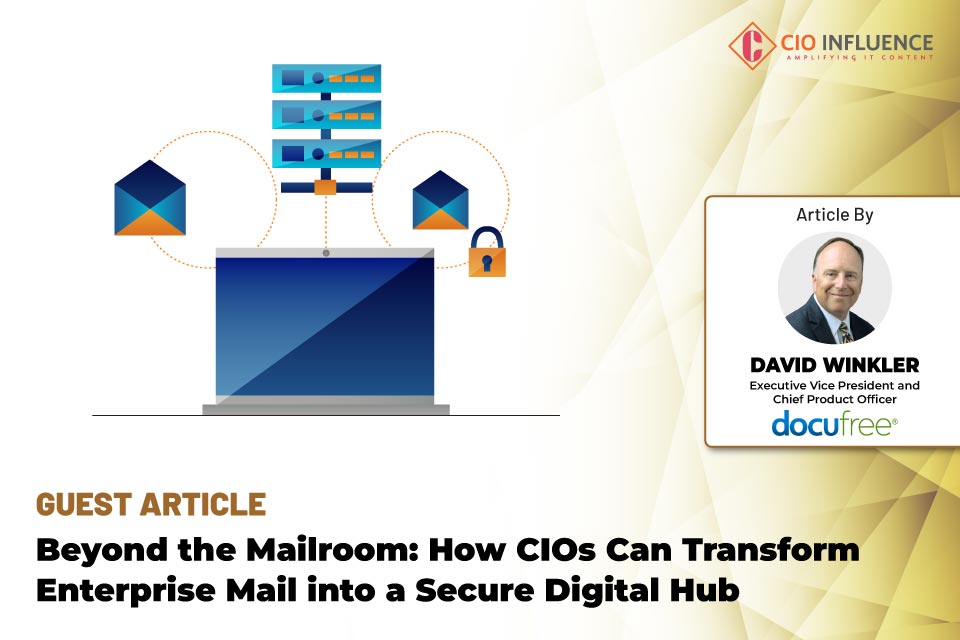By hrtechcube – July 28,2021
David Winkler, Executive Vice President and Chief Product Officer, Docufree talks about the role of document management for reaping enhanced ATS and HRtech benefits
1. Tell us about your role at Docufree
I am Executive Vice President and Chief Product Officer at Docufree. My responsibilities include: product development and management; marketing and channel partnerships.
2. Can you tell us about your journey into this market?
My career spans 25+ years, working in technology services, business development and consulting for firms such as EDS, Microsoft, Oracle, Mobius and Ricoh prior to Docufree. I have developed a passion for helping organizations leverage and apply their technology investments to solve their most complex business challenges—dealing with large volumes of disparate information.
3. How do you think technology is revamping the HR Sector?
“The impact of mobile technology on organizations is already profound. It is changing the way people connect with each other and is reshaping the way enterprises are formed, organized, and operated.”
Like previous transformative technologies, such as the PC and the internet, mobile technology provides fresh opportunities for companies to help transform core functional HR processes. This transformation can open the door to increased productivity, improved employee satisfaction, and the ability to communicate instantly with key constituents. Our “new world of work” now requires a company’s HR information to be as mobile as its workforce.
4. How is digitization changing the face of document management?
To a greater or lesser extent, organizations are document-centric. When I say “document,” I’m referring to a container of information that might be printed and/or electronic in nature. Today this thing we call a document is a lot more than just printed information. It’s a digital asset that gets created in many different formats. Some are in a proprietary printer format but others include image files, HTML, XML, audio, video, animation, desktop or transaction data. Documents are mission-critical, and documents are strategic to the success of the enterprise. Approximately 90 percent of all corporate information is contained in documents (digital and paper). Organizations continue to become more and more document-centric, and this is caused by the sheer volume of documents produced by ERP systems, HRMS applications, reporting requirements, legacy environments, e-mail, the internet and other disparate applications. Bottom line…digitization is fueling e-business initiatives that are strategic to helping organizations stay competitive. The voice-of-the-customer informs us that C-level executives understand the importance of having a 360-degree view of their customers. And, that delivering accurate, timely information to these customers as well as to their employees, partners and suppliers is mandatory.
5. With modern document connectors, how can employers make the most out of their ATS?
Docufree’s ATS connectors enable access to new-hire documents from the applications an HR team uses every day and helps ensure a company has a complete—and easily accessible—employee file. Breaking down information silos between ATS and other HR applications brings many benefits:
- Keeping documents consistently categorized according to established rules for quick search and retrieval;
- Bringing employee records together into one central, secure location; and
- Creating easy integration (point, click, configure) of ATS documents with zero coding effort.
6. The ability to be up and running in minutes without complex technical requirements, how can employee self-service be simplified with records management?
Properly deployed self-service portals to conduct a wide range of HR transactions that were formerly conducted via paper transactions and/or via email+file attachments can yield more simplified records management. Consolidation of information into one central and secure location for administering retention and disposition rules is extremely important. Costs decline as employers consolidate redundant information and web pages, and productivity improves as employees spend less time looking for the information they need. Some examples of such employee self-service transactions include employee personal data and updates; benefits enrollment and updates; employee training/e-learning; performance management; and time and attendance.
7. What is the role of Improved accessibility to new hire documents for better talent acquisition?
The adoption of mobile applications for human resource (HR) functions continues to accelerate. Among the first and most popular HR applications of mobile technology was recruiting. The explanation for this is… the vast numbers of Gen Xers (those born between 1965 and 1980) and Millennials (born after 1980, through the late 1990s) were among the first to adopt mobile technology and search for jobs in great numbers via mobile.
8. With the migration to the cloud movement, how can this be of benefit to classification and indexing of documents?
The convergence of cloud-services and document management can eliminate paper employee files and significantly reduce administrative work for HR while improving compliance. Self-service combined with automation can create an efficient digital workflow between HR, managers and employees to replace the inefficient paper shuffling still found in too many companies. The ability to capture, classify, index, store and share multiple document types results in better organization and easier search-and-find activity—and eliminates manual keying of data that’s ready to automate and integrate with the applications you use every day.
9. Docufree recently launches ADP® Recruiting Management Connector. What does this entail for the new hire records?
HR departments live in a hybrid paper and electronic world. Because centralizing and integrating documents and data spreads across file cabinets, emails, network folders and disparate applications, it is an extremely complex challenge. Both existing and new incoming documents are automatically retrieved the moment they arrive in ADP® Recruiting Management. Documents are automatically identified and categorized by type, according to HR’s category structure. Documents and their associated properties (i.e. metadata fields) are automatically uploaded to the correct destination. No more manual document capture, uploading, importing or categorizing required. Docufree’s ADP RM Connector makes it easy, fast, and secure with an entire suite of HR records management and process-automation solutions that integrate with existing applications.
10. How do you prepare for an AI-centric world?
As both a company and an individual, you have to be open minded to change and curious about AI as its rapidly evolving. Learn about different components, both machine-learning and deep-learning models. We’re finding that organizations are most successful at implementing AI when they start by reimagining a core process, journey, or function (i.e. a domain) end-to-end with the technology. In so doing, they can take full advantage of AI while reducing development time and costs.
11. What are the major developments you are planning, in recent times?
Our solutions’ roadmap is loaded with new developments as we’re constantly seeking voice of customer and voice of market to feed and drive enhancements. We’ve recently launched our eSignature, HR-Onboarding and Digital Mail for Law Firms service offerings. In addition, we’re planning to release new continuous and multi-factor biometric security capabilities embedded into our proprietary Document-Cloud platform—that reduces the risk of cyber fraud and data leaks for businesses that share highly sensitive files such as financials, legal contracts, employee information, new innovation ideas, and more. This will be especially important as we enable information to be as mobile as a company’s workforce in the new world of work.
12. How does your team empower and support you?
My team has an incredible work ethic and they’re always learning and adapting to a pretty fast-paced environment. We’re often pulled in many directions whether it be internally by sales, customer success or externally by clients, partners or suppliers. Team members are very responsive to my requests and produce high-quality results. Rarely do I need to have work re-done due to missing the objective.
13. What movie inspires your the most?
“The Pursuit of Happyness” from 2006 with Will Smith. “Don’t let anyone ever steal your dream!”
14. Can you give us a glance of the applications you use on your phone?


David Winkler, Vice President and Chief Product Officer, Docufree
David Winkler is Executive Vice President and Chief Product Officer at Docufree, a business-process services provider of large-volume document scanning, cloud-based document management and intelligent process automation.




